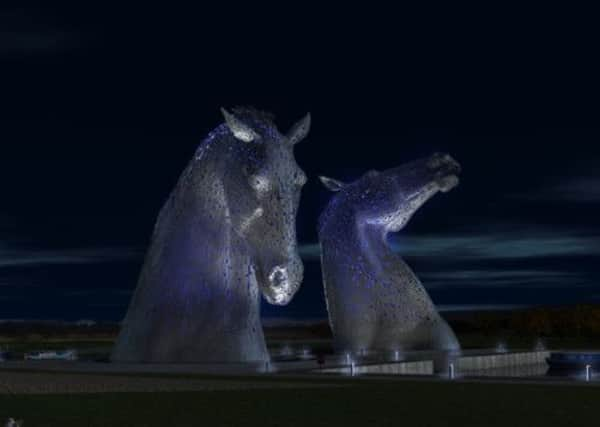Horse-head sculptures attraction set for canal hub


The huge horse-head sculptures will not only be Scotland’s tallest works of art, but will help create a dramatic new gateway to a vast new visitor attraction taking shape in central Scotland.
The two sculptures are expected to attract almost half a million visitors a year to a new canal hub which has been created as the centrepiece of The Helix – a £43 million project to transform a 350-hectare swathe of previously unused land, close to Falkirk Football Club’s stadium.
Advertisement
Hide AdWork is to start next week on the Kelpies, designed by artist Andy Scott, which are believed to be the largest steel horses’ heads to be built anywhere in the world. Incredibly, they are due to be constructed within just 75 days at a new turning circle which is nearing completion beside the existing Forth and Clyde Canal.
A huge logistical operation is underway to transport the vast pieces of the sculptures from a plant in north Yorkshire where they have been manufactured to a supermarket operator’s warehouse on a neighbouring site to The Helix development. Public access to the canal area will be kept open during the construction period to allow people to see the giant works of art take shape.
State-of-the-art technology is being installed inside the horses’ heads as part of a major visitor experience expected to be up and running by the spring. The parkland area around them is planned to become a regular home for festivals and events in Falkirk.
However, the sculptures themselves are being touted as Scotland’s answer to the Angel of the North, Antony Gormley’s famous sculpture in Gateshead, although the Kelpies will be almost a third taller.
A separate part of the vast site of The Helix – next to the West Mains Industrial Estate in Falkirk – will be turned into a new park, complete with lagoon for watersports, cafe and children’s play area by the autumn of this year. The entire project was given the green light in November 2007 when it emerged that the Big Lottery Fund had awarded it a £24 million grant – more than half the overall cost of the project. It was envisaged as a follow-up to the hugely successful Millennium Link project, completely in 2002, which created a major new canal link between Edinburgh and Glasgow in the form of the massive rotating boat lift, the Falkirk Wheel.
Steve Dunlop, chief executive of Scottish Canals, says: “This project was partly envisaged at the time of the Millennium Link, but the funding wasn’t available at the time. We were asked by the government to look at new opportunities and we began to formulate ideas on how we could extend the canal in this area and bring the surrounding land into much better use.
Advertisement
Hide Ad“We saw the Big Lottery Fund beginning to emerge, made the project much bigger than simply about the canal, and were actually the most successful out of 770 bids. This area was previously a disconnected place between Falkirk and Grangemouth and all 10 communities that sat around the edge of it were the most economically and socially challenged in the whole district by some way.
“What the project does is become a joining space – it connects these communities to each other, but also connects them to economic opportunity in the middle. That idea was kind of what won the bid six years ago. It is unimaginable the size, scale and impact the Kelpies are going to have. There’s no doubt about that. It is not art for itself, it is describing change and a sense of confidence in the area.”
Advertisement
Hide AdMike King, programme director for The Helix, says “Although the Kelpies are going in right next to the existing canal, we’re creating a number of new facilities, which will create massive new opportunities for the whole area. The main thing is opening the canal up properly. There were a lot of navigation constraints on the existing River Carron, particularly things like overhead obstructions. The Kelpies will be going in on either side of a new turning pool for canal boats, there is a new lock and an extension of the canal down underneath the motorway and down to the River Carron. It will make a huge difference.”
Horses’ heads were envisaged almost from the outset of the project, partly because of the animal’s links to the industrial heritage of central Scotland and the mythical Scots legend of water-based spirits or kelpies, as they are also known.
Andy Scott, who has been involved with the scheme for the last six years, says his design has even been inspired by Carnera, a horse which once pulled the wagon of the soft-drink manufacturer AG Barr, makers of Irn-Bru, in the 1930s. The firm was set up in Falkirk in 1874 by Robert Barr. He says: “As far back as six years ago I wrote of the Kelpies as monuments to the horse and a peaen to the lost industries of the Falkirk area and of Scotland. I wrote of working horses. Of their role in the progress of modern society, as the powerhouses of the early industrial revolution, the tractors of early agriculture and, of course, the first source of locomotion for barges on the Forth and Clyde Canal which the Kelpies will soon inhabit.”
Mr Dunlop adds: “If you are bold and ambitious, as with the Falkirk Wheel, it has an impact. The Angel of the North changed the whole mindset in the north-east of England.
“Over five, 10 and 20 years, people will come from all over the world to see this.”